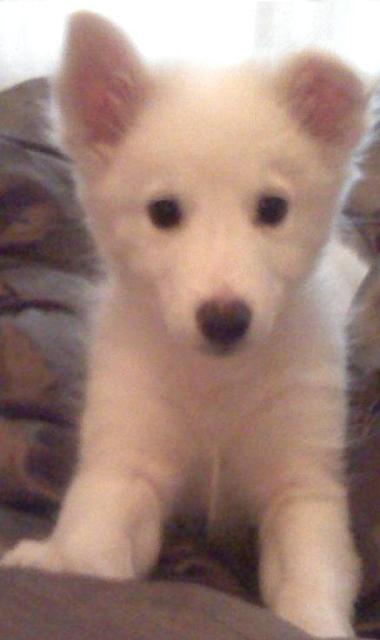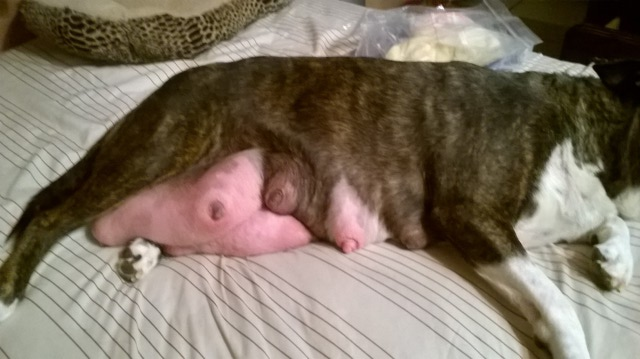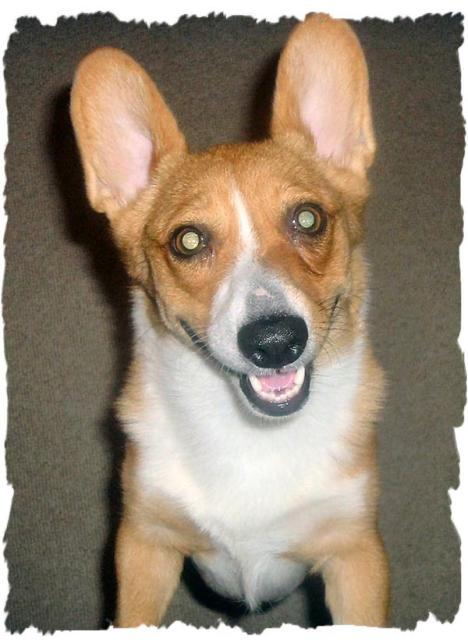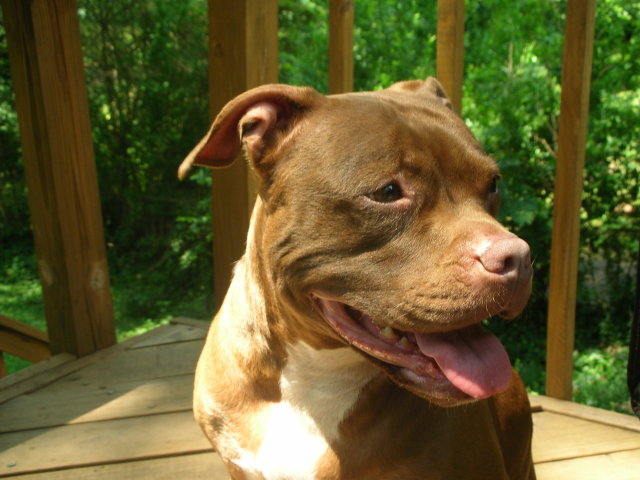QuestionHello,
within a little over a month, It will be 6/8 weeks of age, I will be feeding it purina puppy chow, is this an o.k brand to feed? if not what would be better but not too expensive?
At what age should I start basic commands? hw are Jack Russel's with training... are they smart dogs?
Thank you for any help in advance.
AnswerHi and thanks for asking! Those are very good questions. Jack Russell Terriers (now known as Parson Russell Terriers) are very smart, but they are extremely active, and <i>can</i> be difficult to train because of their hyperactivity. During the first week or so, you'll just want to focus on making sure he is comfortable in his new home. Get a crate that will be just big enough for an adult Jack Russell (hereinafter referred to as a JR) to lie down, stand up, and turn around in. You don't want it to be too big, because if it's too big, he will sleep in one end and use the other end to go potty. Right now, it will be rather large for him, so put his bed on one end and his food and water dishes near the door so that he has as small a space as possible. Of course, since he is so young, accidents will happen. At this point, you don't want to scold him or punish him for 'going' in his crate because he doesn't know any better yet, and he can't hold it for very long yet. If he has an accident, just quickly clean it up. Using a vinegar solution that's 1 part vinegar to 4 or 5 parts water is a good enzymatic solution that will get rid of the odor that might draw him to 'go' in the same spot again later. Nature's Miracle cleaner is also a good enzymatic cleaner if you'd rather buy one.
To start, you may want to have the crate in your bedroom so that he will not feel like he's been abandoned and cry all night. Putting a heating pad on the lowest setting, or a hot water bottle under his crate or blanket (I prefer a heating pad under the bottom of the crate where his bed or blanket will be) will help to keep him comfortable and warm, and make him think that he's laying next to a warm body - like his mother. Putting a ticking clock next to his crate will also help, because that mimics the mother's heartbeat. More than likely, he will cry the first night. You MUST ignore him. If you talk to him, or get up and let him out of the crate, he will learn that if he cries, you will come and give him attention. IF you can, it might be best to get him on a Friday. That way, you'll be able to either sleep in on Saturday or take a nap to catch the ZZ's you lost the night before. ;)
To start with, you won't want to give him free-access to food and water, because that will slow down housetraining. You'll need to give him his food throughout the day; he should receive at least three meals a day. Based on the type of food you choose, he should get a total of about 3/4-1 cup daily, so you'll want to feed him about 1/4 cup at each meal. If he has trouble eating it, or doesn't seem interested, you can moisten it with 1-2 tablespoons of warm water or warm chicken broth. When you give him his food, also give him his water bowl. Give him 15-20min. to eat, and then take away his food. If you have moistened it, throw whatever is left away. Leave his water down for 30-40min, then take it up and dump it out. Take him outside immediately (either on a leash, with either a flat collar or a harness; or buy a 'puppy playpen' and put him in it in the spot in your yard where you want him to eliminate) and just stand and wait until he 'goes'. Do not talk to him, pet him, or play with him until after he has gone to the bathroom outside. AFTER he has finished doing his business, praise him excitedly and then you can play. This will help him to quickly learn that when he 'goes' outside, he gets lots of attention and playtime. This again, will help speed housebreaking along. As a general rule, dogs go to the bathroom within 20min. of eating, and puppies can hold their bladders for as many months as they are old. For example, since he will be about 2 months old, he should be able to hold his bladder for about 2 hours. If he has an accident after just 1.5 hours, you'll know you should be taking him outside at least every 90 minutes. Prevention of accidents is the best way to housebreak a dog.
The first thing training-wise you'll want to start out with is the "come" command. You can start immediately. The earlier you start training, the easier it is. Now; when you first get him, he will probably eagerly follow you around. So, when you get up to go somewhere, tell him "(Name) come!" You don't have to holler at him, but say it in a normal, conversational tone, as if you were just talking to someone. As he bounds after you, tell him "Yay! Good boy! Good puppy! Yay!" in an excited, high-pitched, happy tone. After a few steps, stop and pet him and tell him what a good boy he is. Then, repeat. Say "(Name) come!" and walk a few steps, praising him as he follows. After a few steps, stop and pet him again. Once he catches on, you can start walking further and further. If he's interested in treats, you can lure him along with the treat, and give it to him when he gets to you.
To keep him from getting into things or having accidents, another good training suggestion is to tether him to you while you're at home. This allows you to keep an eye on him and also teaches him to pay attention to you. If you notice him starting to sniff around or start to squat, you can immediately scoop him up, say "go outside!" and take him outside to go potty. After the first few times, you should be able to just say "go outside!" and hurry over to the door with him following behind you. This is what you want, because it will teach him that he must go to the door instead of you carrying him outside every time. If you see him start to chew on something he shouldn't, or whatever, if he's tethered to you, then you can tell him "no" and direct his attention elsewhere. Have a few chew toys that you can substitute for inappropriate items, and praise him for chewing on them.
Now, as for what kind of food would be best, I do not recommend Purina products at all. That includes Dog and Puppy Chow, Beneful, Alpo, ONE, and Pro-Plan. If you <i>must</i> buy Purina, then go with ONE or Pro-Plan. The following is a list of foods that I would recommend to people on a budget. At first they may seem more expensive, but when you consider the amount you have to feed, and the amount of cleanup (waste produced), they actually equal out to about the same or less than the cheaper brands. Brands like Purina, Kibbles n' Bits, Iams, Eukanuba, Science Diet, and Pedigree, as well as store brands, are not as easily utilized by the dog, so you end up with more waste produced. They contain fillers like corn gluten, whole grain corn, and soy products that serve no purpose other than to make the dog feel full. They pass right through the dog's body and end up in your yard. They also contain things like 'by-products' and 'meat meals' that are made up of bones, feet, blood, necks, horns, hooves, feathers and fur, and other parts of the animals that are not used for human consumption. Meat meal can even include animals that have died of disease, and may or may not be rotting. Meat meal can come from any animal, and is not limited to livestock.
The following foods do not contain 'by-products' or 'meat meals'. They also do not contain fillers like corn and wheat, which can also cause allergies in dogs that can cause skin conditions and foot-chewing. They may cost a little more per bag, but in the long run, the costs equal out because the dog is more healthy; you have less waste to clean up because the dog is able to absorb and use more of the nutrition in the food, and as a result you feed a little less per sitting and you don't have to buy food as often. I have a 60 pound pit bull/chow. A 20 pound bag lasts for more than a month because she doesn't have to eat as much as if she were eating Iams (which also is the manufacturer of Eukanuba), or Purina, or Pedigree, or Science Diet. That 20 pound bag costs me between $20 and $25 (depending on if it's on sale or whatever), so I only spend $25 a month to feed a 60 pound, muscular dog. In three days I spend at least that much to feed myself!
So, here is a list of foods that <b>I</b> would recommend, based on the fact that you say you're on a budget:
<b>Bil-Jac</b> - Now, this food does contain corn, so at first glance it may seem that I've made a mistake. However, based upon first-hand experience, and extensive research into how they actually make the food, I feel comfortable recommending it because even when fed to a dog with allergies to corn, his allergies all but disappeared. It has everything to do with the way the Bil-Jac company prepares its food. They do not use a rendering process like most dog food companies. Instead, they slow cook the ingredients at a lower heat. They cook the meat separate from the grains, instead of putting everything into a big vat and cooking it on such high heat that they have to add back the nutrients and flavor at the end of the process. When looking at the list of ingredients on the Bil-Jac bag, you may also notice that it says it contains by-products. However, they use ONLY the organ meat, which does not include the things I mentioned above as being in by-product meal. The reason they have to call it by-product meal is because anything that is not used for human consumption has to be called a by-product.
Now that you're totally confused, here are the rest of the recommended foods:
<b>Nutro Natural Choice</b>
<b>Nature's Recipe</b> - Their regular food does contain wheat, which <i>can</i> be an allergen, but they also have an allergy line made with venison if your dog is allergic to wheat.
<b>Chicken Soup for the Dog Lover's Soul</b>
<b>Innova</b>
<b>California Natural</b>
<b>Healthwise</b>
<b>Karma Organic</b>
<b>Eagle Pack</b> - They use corn, but they also process it a bit differently than other brands. I prefer the holistic line, but it is a little more expensive.
<b>Canidae</b>
<b>Wellness</b> - Made by Old Mother Hubbard
<b>Solid Gold</b>
That's a start. If you need anything else, or want some more information on one or more of the foods I've mentioned, please don't hesitate to let me know.
Kristen

 Pomeranian digging in beds and clothes
Question
Charlie my Pomeranian
I have a Pomeran
Pomeranian digging in beds and clothes
Question
Charlie my Pomeranian
I have a Pomeran
 New Eskimo puppy
Question
Honey the shy american
I just got my 10 week o
New Eskimo puppy
Question
Honey the shy american
I just got my 10 week o
 Engorged Breasts
Question
mamma
My Friends Dog Had A Litter About
Engorged Breasts
Question
mamma
My Friends Dog Had A Litter About
 my 3 year old welsh corgi
Question
Bella
I have 2 old cairn terriers, 12 and 15 (
my 3 year old welsh corgi
Question
Bella
I have 2 old cairn terriers, 12 and 15 (
 Coping with Incontinence
Question
Abi
Abi, my 8 year old female spayed pit bull,
Coping with Incontinence
Question
Abi
Abi, my 8 year old female spayed pit bull,